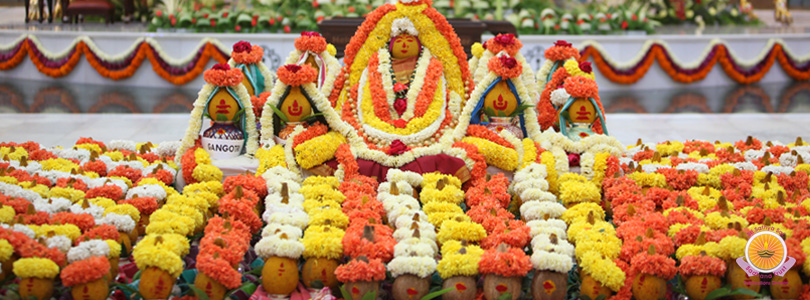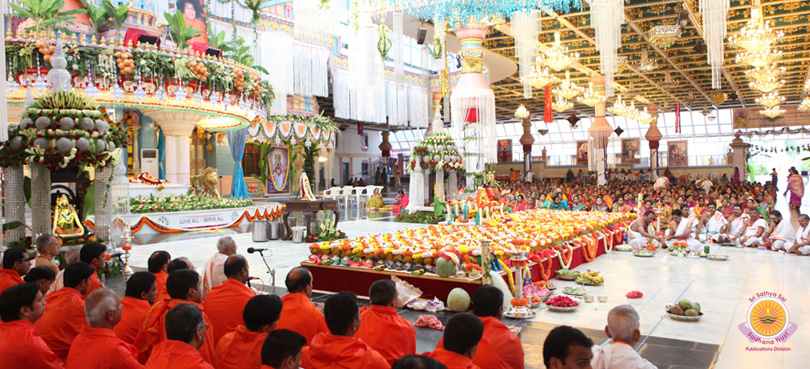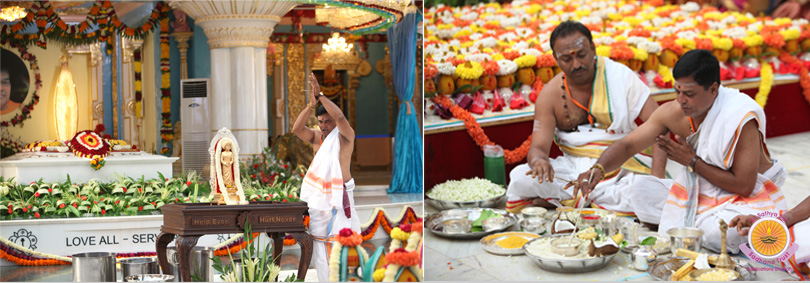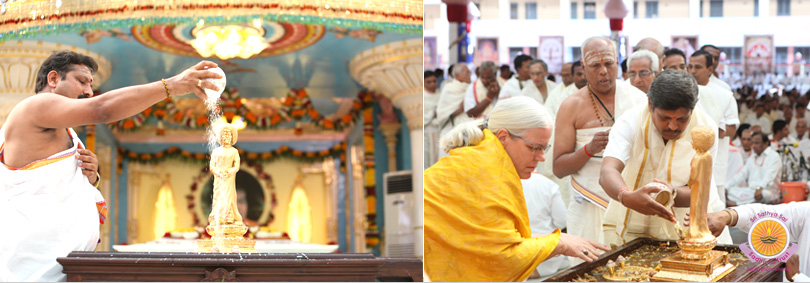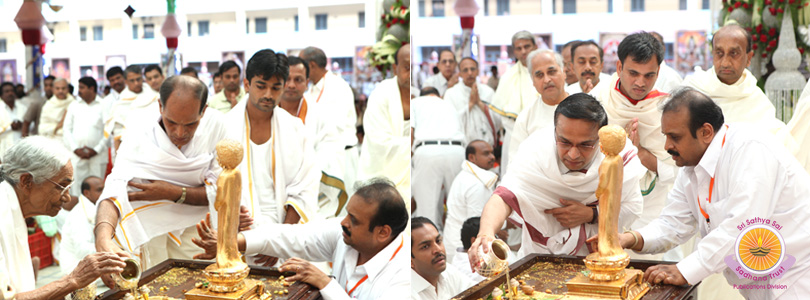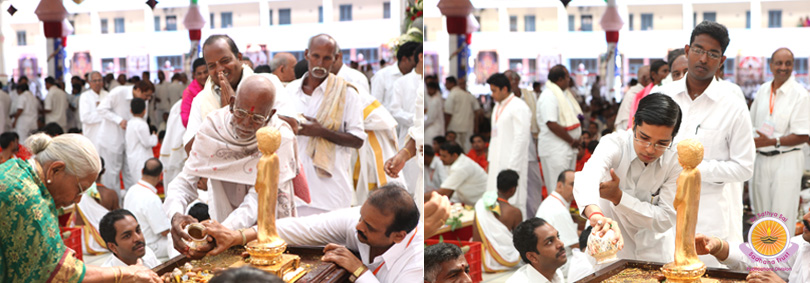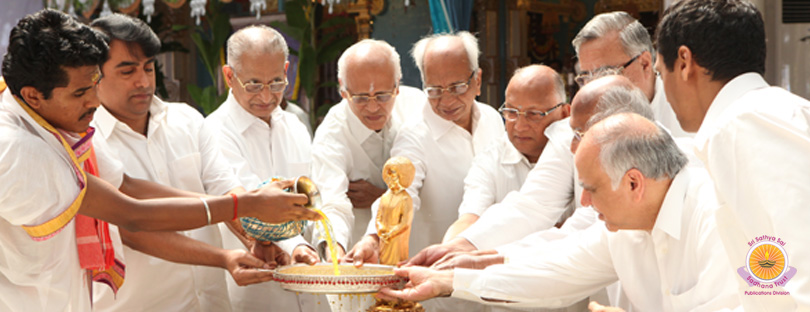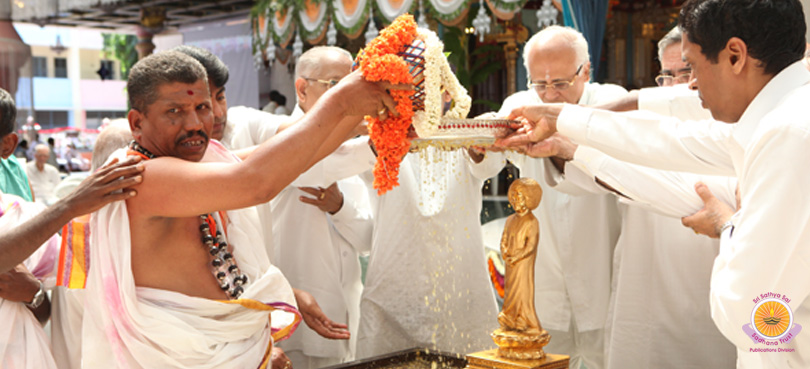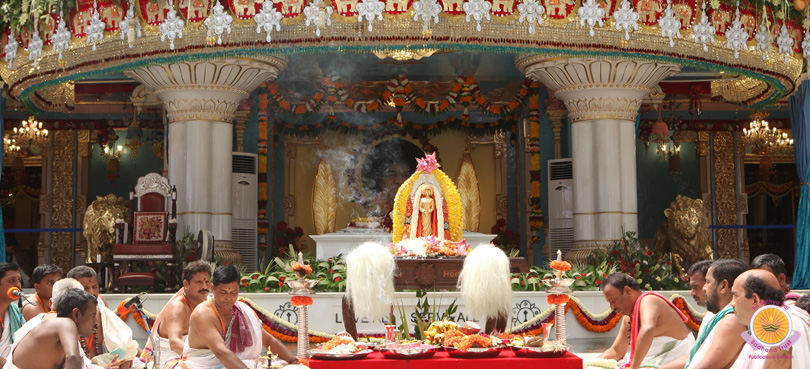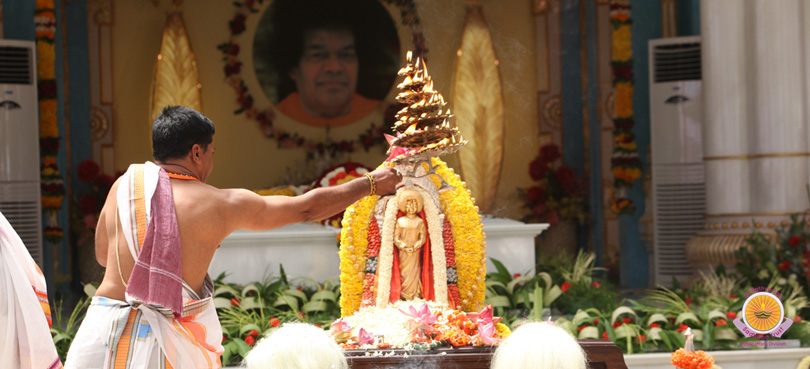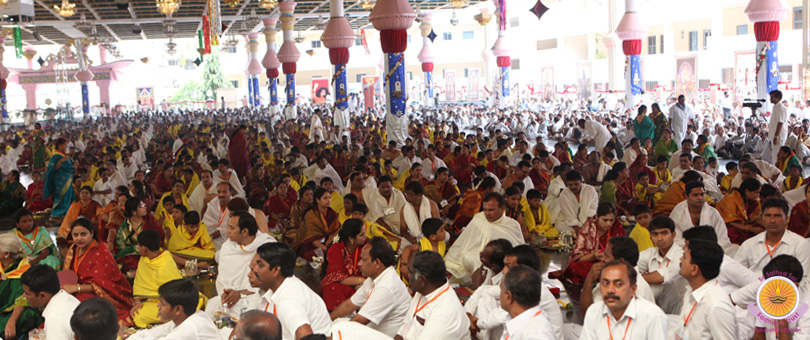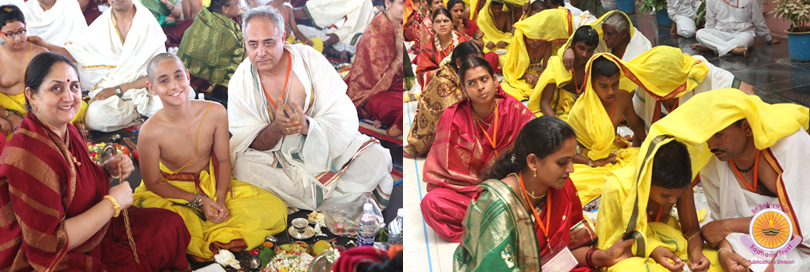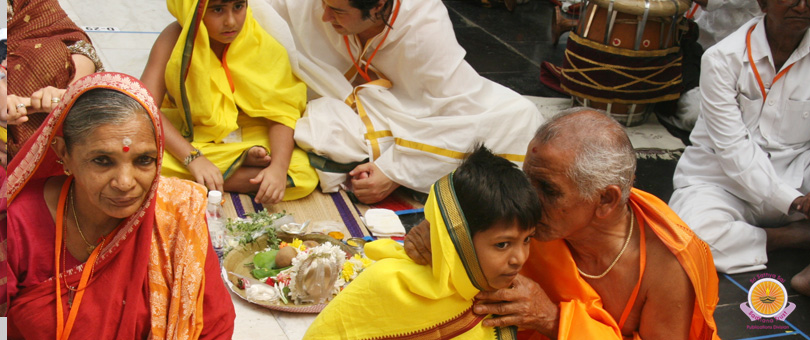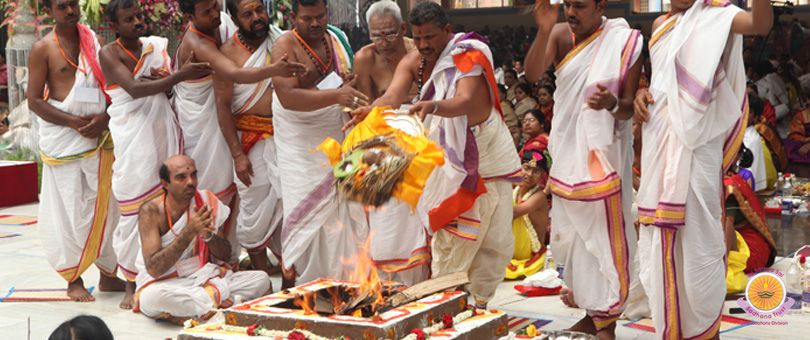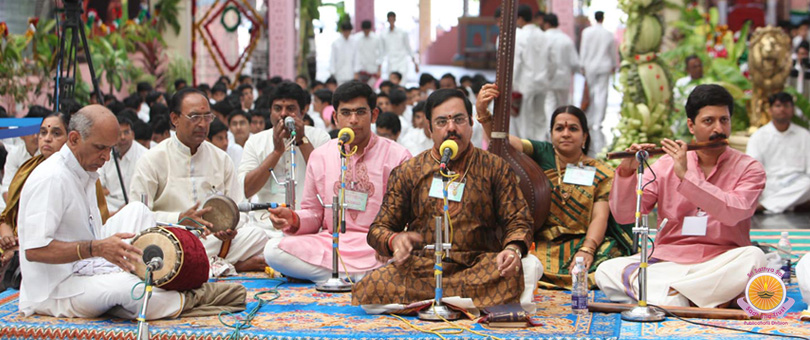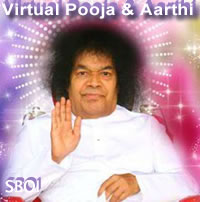|
|||
|
|
|||
| Text & photo source - copyrights: Sri Sathya Sai Sadhana Trust - sssbpt.org - Radiosai.org Prasanthi Diary - theprasanthireporter.org | Web layout - Photo graphic design : saibabaofindia.com "SBOI" | - We gratefully acknowledge the publishers Sri Sathya Sai Sadhana Trust & Sri Sathya Sai Media Foundation | |||
| Maha Sahasra
Kalashabhishekam for Universal Peace and Prosperity… (Brahmopadesham by Bhagawan…updated on 27-09-2012) Wednesday, September 26th, 2012 |
|||
| Morning Glory for the day was
enhanced manifold with the auspicious offering of Maha Sahasra
Kalashabhishekam at Bhagawan’s Divine Lotus Feet this morning here n
Prasanthi Nilayam.
The Maha Sahasra Kalashabhishekam was organised with the theme “Samasta Lokah Sukhino Bhavantu”, aiming at universal peace and prosperity. The ritual involved offering of sacred water collected from 1108 rivers from across India. More than thousands of devotees participated in the rituals that lasted for five and a half hour.
In the morning, the programme commenced at the scheduled hour, 0600 hrs. with Veda chanting for fifteen minutes, followed by Sankalpam, the introductory ritual involving identification of name, gothra, place, object of the ritual etc., followed.
Even as Vedic chanting reverberated in the vast Sai Kulwant Hall, the proceedings continued with various ritualistic offering done at a make-shift altar, erected right in front of the Sanctum Sanctorum. The offerings included Abhishekam done with Milk, Ghee, Curd, Turmeric Water , Kumkum Water, Rose Water, Coconut Water, etc.
Subsequently, Pranapratishta, infusing life-force into the ‘Deity’, Shodashopachara Puja and Yajnopaveetam continued before the actual rituals began at 0800 hrs.
Maha Sahasra Kalashabhikam began at 0800 hrs. and continued for two hours with 1108 Kalashas being offered by as many participants. Participants made a beeline, ladies and gents separate, to the makeshift altar, in disciplined order, making the offering. Once the last person also offered the Kalashabhishekam, the idol was cleaned and decked up nicely with flower garlands before the final offerings and Mangala Arathi to the ‘Deity’.
Bhajans by the Youth of Bangalore continued for sometime before the final phase of Maha Kalasha Abhishekam began just after 1030 hrs. Ashtothara Shata Namavali, 108 Holy Names of Bhagawan and Ashtavadhana Puja followed before the final Arathi pertaining to the day’s ritual was offered.
Even as Prasadam distribution began, bhajans continued until 1120 am when Mangala Arathi was offered.
The venue Sai Kulwant Hall was decked up befitting the auspiciousness of the occasion with a riot of colours all over. A huge cut-out of Mother Gayathri was placed at the centre, hanging from the ceiling, facing the Sanctum Sanctorum. Colourful buntings, especially the ones made of fresh green palm leaves along with flowers of various hues enhanced the beauty of the auspicious morning.
As part of the programme, in the evening, eminent scholar S. Ranganathan, Director RV Institute of Sanskrit Studies, will speak on the esoteric significance of Gayathri Mantra and Upanayanam.
II Samasta Lokah Sukhino Bhavantu II Text & photo source - copyrights: Sri Sathya Sai Sadhana Trust - sssbpt.org - Radiosai.org Prasanthi Diary - theprasanthireporter.org | Web layout - Photo graphic design : saibabaofindia.com "SBOI" | - We gratefully acknowledge the publishers Sri Sathya Sai Sadhana Trust & Sri Sathya Sai Media Foundation
|
|||
|
Brahmopadesham by Bhagawan… Thursday, September 27th, 2012 |
|||
After yesterday’s grand Maha
Sahasra Kalashabhishekam performed in the Divine omnipresence,
this morning Prasanthi witnessed another grand ritual, Samoohika
Upanayana Brahmopadesha Mahotsavam, initiating spiritual
aspirants into Gayatri Mantra along with investiture of the
sacred thread or the “Yagnopavit”.
The function was attended by over six hundred
aspirants, Vatus, accompanied by parents.
Upanayana is also called the ‘sacred thread ceremony’, as the child is bestowed with the Yajnopavita. The Yajnopavita, or ‘sacred thread’, is made up of three strands of thread, which signifies the three responsibilities that the child takes upon itself: responsibility towards the parents, responsibility towards the knowledge or the Master, and responsibility towards the society.
Upanayana is a sacred ceremony which is traditionally seen as getting a new birth in the spiritual world towards the higher knowledge of the Self. It is an initiation process to learning the sacred chants and mantras according to the Vedic tradition. During the ceremony the young boy is taught the secret of life through Brahmopadesha (revealing the nature of Brahman, the Ultimate Reality) or the Gayatri mantra. After this ‘new birth’, one is traditionally called a dvija, or ‘twice-born’. One was then eligible to start his Vedic studies under the guidance of an Acharya (teacher), which would ready him to become a responsible member of society, fit to serve society, and equipped with the knowledge to lead a happy, healthy and successful spiritual oriented life.
This morning’s proceedings began at 0800 hrs. with Veda chanting by the Youth from Bangalore, lasted for fifteen minutes. The Samoohika Upanayana Brahmopadesha programme commenced at 0815 hrs. and lasted for a long three and a-half-hour ending at 11:45 with Mangala Arathi.
The ‘Vatus’ along with their parents were seated in different clusters, spreading over in the spacious Sai Kulwant Hall. Ritualistic proceedings included various steps involved in the Upanayam ceremony, Ganapati Puja, Punyahavachana, Navagraha Puja, Yajnopaveetham, Brahmopadesham, Ajyabhaganta Homa, Bhiksha Karana and Kumara Bhojana. Even as the group of priests, went on guiding the ‘Vatus’ with instructions guiding them into various steps, in English, Telugu and Kannada, ‘Vatus’ along with parents completed the task, lasted for three and a-half-hour. After Poornahuthi offering at the Yajna Kunda, Yajnopaveetam was done before Brahmopadesha, initiation into Gayathri Mantra, was administered by Bhagawan, with Gayathri Mantra in His recorded voice, resounding all over.
A couple of bhajans and Mangala Arathi followed before all the Vatus along with their parents circumambulated the Sanctum Sanctorum in the Mandir. Subsequently, all the Vatus went ahead in procession circumambulating the Peepul tree opposite the Ganesh Mandir.
A sumptuous feast was arranged in the South Indian canteen, open for all devotees.
Marking the grant festivity, a Carnatic Music programme was offered by RK Prasanna Kumar and Party, in the evening in Sai Kulwant Hall. The accomplished artiste regaled the audience for an hour with some of the finest Carnatic compositions, singing paeans to the Divine; his numbers included Brochevarevarura, a special composition by Mysore Maharaja on Mother Gayathri etc.
At the end of the programme, the artiste and
accompanists were felicitated by Ashram officials. Bhajans continued
and Prasadam was distributed before Mangala Arathi offering at 1830
hrs.
|
|||
|
Online Pooja &
Aarthi
|
